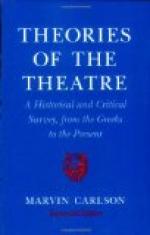Most of our American playwrights, like Juliet in the balcony scene, speak, yet they say nothing. They represent facts, but fail to reveal truths. What they lack is purpose. They collect, instead of meditating; they invent, instead of wondering; they are clever, instead of being real. They are avid of details: they regard the part as greater than the whole. They deal with outsides and surfaces, not with centralities and profundities. They value acts more than they value the meanings of acts; they forget that it is in the motive rather than in the deed that Life is to be looked for. For Life is a matter of thinking and of feeling; all act is merely Living, and is significant only in so far as it reveals the Life that prompted it. Give us less of Living, more of Life, must ever be the cry of earnest criticism. Enough of these mutitudinous, multifarious facts: tell us single, simple truths. Give us more themes, and fewer fabrics of shreds and patches.
XIV
THE FUNCTION OF IMAGINATION
Whenever the spring comes round and everything beneath the sun looks wonderful and new, the habitual theatre-goer, who has attended every legitimate performance throughout the winter season in New York, is moved to lament that there is nothing new behind the footlights. Week after week he has seen the same old puppets pulled mechanically through the same old situations, doing conventional deeds and repeating conventional lines, until at last, as he watches the performance of yet another play, he feels like saying to the author, “But, my dear sir, I have seen and heard all this so many, many times already!” For this spring-weariness of the frequenter of the theatre, the common run of our contemporary playwrights must be held responsible. The main trouble seems to be that, instead of telling us what they think life is like, they tell us what they think a play is like. Their fault is not—to use Hamlet’s phrase—that they “imitate humanity so abominably”: it is, rather, that they do not imitate humanity at all. Most of our playwrights, especially the newcomers to the craft, imitate each other. They make plays for the sake of making plays, instead of for the sake of representing life. They draw their inspiration from the little mimic world behind the footlights, rather than from the roaring and tremendous world which takes no thought of the theatre. Their art fails to interpret life, because they care less about life than they care about their art. They are interested in what they are doing, instead of being interested in why they are doing it. “Go to!”, they say to themselves, “I will write a play”; and the weary auditor is tempted to murmur the sentence of the cynic Frenchman, “Je n’en vois pas la necessite.”




